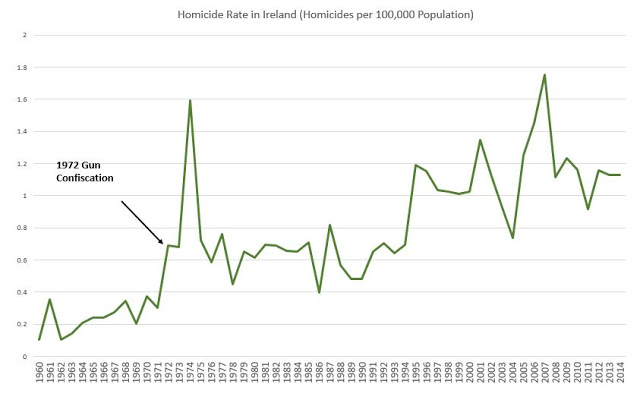Say what you will about the NRA and failure to score the things they should about politicians (and I’ve said plenty), but American Rifleman fields a great article from time to time. Hence, they have come through with Guns Of The Easter Rising.
On Easter Monday, April 24, 1916, scattered groups of men of the Irish Volunteers and Irish Citizen Army, as well as women of the nationalist auxiliary organization, the Cumann na mBan, assembled at their mustering points throughout Dublin. Most of them were unaware that, instead of meeting for a routine maneuver, they were embarking on an armed uprising against the British Crown. Due to a series of mishaps and intrigues, only a fraction of the Volunteers’ nominal strength actually reported for duty. While some were in the green uniforms of the Irish Volunteers or the Citizen Army, the majority of them were in civilian clothes, and they carried an amazing assortment of firearms.
The Easter Rising of 1916, or as it is sometimes known, the Easter Rebellion, marked a significant shift in Irish-British relations, and is considered by many to be the first stroke of the popular uprising that severed Ireland from the British Crown in 1922. Time and space here do not allow a detailed discussion of the causes of the Rising, but a short introduction is necessary to understand the reasons for the variety of small arms carried in this battle.
A few years before the outbreak of World War I in 1914, the British government pledged to return a semblance of Home Rule to Ireland, after a hiatus of more than 100 years. The northern province of Ulster, populated mainly by Presbyterians who had emigrated from Scotland some 300 years earlier, feared domination by the other three overwhelmingly Catholic provinces, and pledged to oppose Home Rule by force, equating it with “Rome Rule.” In a daring smuggling operation, the newly formed Ulster Volunteer Force armed itself with modern Austrian Mannlicher rifles, obsolescent German Model 1888 “Commission” rifles, and obsolete Italian Vetterli rifles.
The Irish Volunteers (pledged to fight for Home Rule), who had been smuggling in small lots of arms, followed suit when they landed two small boatloads of antiquated Model 1871 German Mauser rifles in Ireland. Arms smuggling on both sides continued right up to the point when Great Britain declared war on Germany in August 1914, resulting in a wide array of shoulder arms and handguns coming into Ireland. Under a mutual agreement, the Home Rule controversy was temporarily shelved for the duration of the war, and both the Ulster Volunteers and the Irish Volunteers (immediately renamed the “Irish National Volunteers”) volunteered en masse for service with the British Army. However, a small number of the original Irish Volunteers (retaining their original name) refused to fight for the government they considered as oppressors.
The article goes on to discuss both the history and the guns used in the Easter Rising. It concludes thusly.
The wide variety of arms in the Easter Rising was a result of a disarmed populace trying to end foreign domination by using whatever firearms it could find. This same motley array of armament would plague the men and women who would fight another war, just three years later, in their successful attempt to make “Ireland, once a province, be a nation once again.”
There are many observations we could draw, but my job is to send readers their direction and let you comment here, because what you say will undoubtedly be better than what I could say. But my oh my, what I wouldn’t give to shoot some of those old guns, the Mauser, Lee-Enfield, etc.
They weren’t properly armed. And they’re not properly armed now either.
While homicide rates at least started to decline over the past decade in England and Wales, there is little sign of any such trend in Ireland at this time.
Ireland has a long history of highly restrictive gun control laws, many of them justified on the grounds of combating the IRA and similar organizations. Gun control was stepped up in the early 70s when new legislation was introduced, accompanied by a large-scale gun confiscation operation that occurred when police asked for guns to be turned in “temporarily” for inspection. The guns were never returned by police.
Since then, the homicide rate in Ireland has increased significantly, and in recent years, Ireland has adopted numerous additional gun control laws in the face of growing homicide rates.
 Source: Graph 9.4 (Retrieved by Google Cache from Central Statistics Office of Ireland.) and this report.
Source: Graph 9.4 (Retrieved by Google Cache from Central Statistics Office of Ireland.) and this report.
So there you have it. Seldom will you find a more telling pictorial depiction of the stolid commitment to presuppositions (i.e., we can control violence by confiscating the firearms of peaceable and law-abiding citizens) than here. They keep pressing confiscation and increased gun regulations, it keeps having the opposite effect of what they claim they want, and they keep doing it.
Or at least, a reduction in violence is what they claim is the reason for gun regulations. Perhaps that’s just a pretext, yes?




